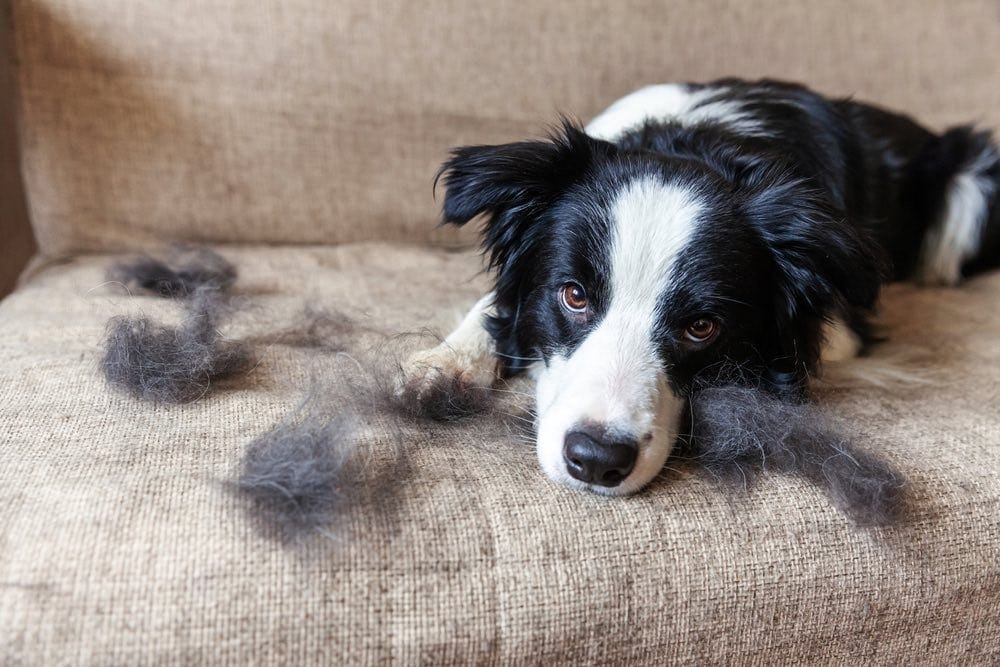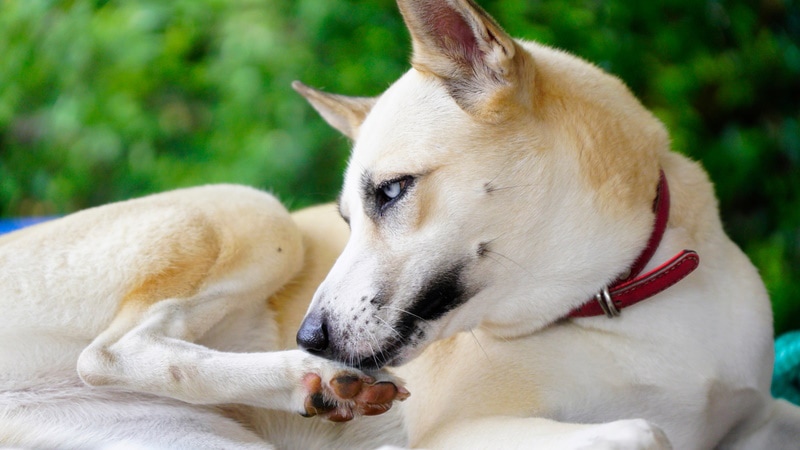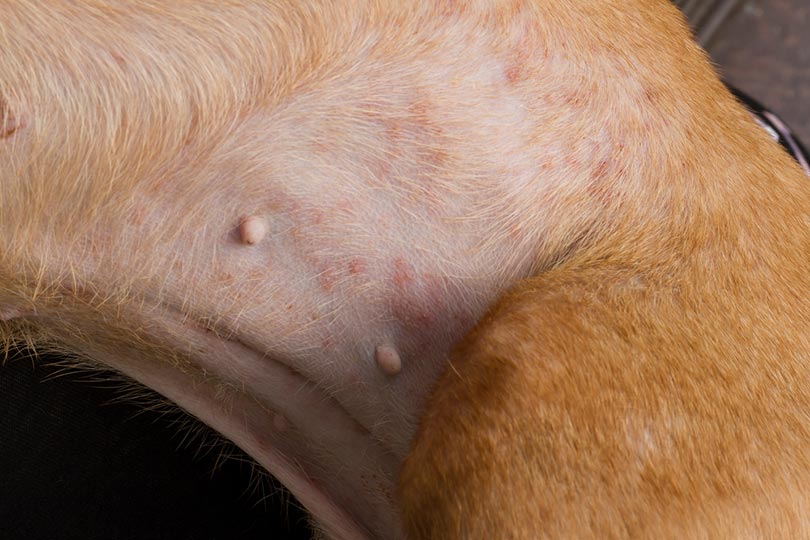Malanees (Great Pyrenees Malamute Mix): Pictures, Care Guide, Temperament & Traits

Updated on
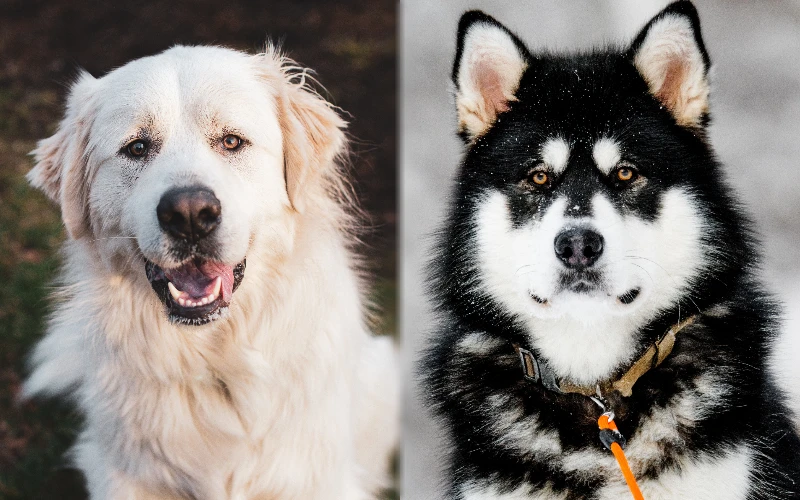
Click to Skip Ahead
The Malanees combines two large working group dogs, the Alaskan Malamute, and the Great Pyrenees, in a powerful yet gentle and family-loving hybrid. With hundreds of years of specialized labor behind both parent breeds, the Malanees has a firm pedigree in purpose, bringing energy and a desire to work to any home.
Though Malanees take care to train and maintain, they are a magnificent mix and exceptional companions for willing and capable owners. If you have the rare opportunity to adopt, we’ll explain what to expect in the care, temperament, and traits of Malanees dogs.
| Height: | 23–30 inches |
| Weight: | 75–100+ pounds |
| Lifespan: | 10–14 years |
| Colors: | White, silver, red, brown, gray, black |
| Suitable for: | Experienced owners, families with older children |
| Temperament: | Loyal & loving, intelligent, gentle, independent, protective, strong-willed, hardworking |
Though the hybrid is relatively new, the Malanees is the product of a pair of centuries-old working dogs. One was a cargo-puller in the Alaskan wilderness, while the other tended livestock in the Pyrenees mountains separating France and Spain.
The Alaskan Malamute traces their lineage to the Inuit dogs that crossed the Bering Strait’s land bridge. The heavy-shedding cold-weather dogs served primarily as sled dogs for pulling heavy cargo long distances. As indispensable multi-purpose helpers, they also worked as hunters and guardians. At the end of the 19th century, miners took in working dogs during the Gold Rush. The breed endured despite crossbreeding threatening their existence, finally earning AKC recognition in 1935.
The large and ancient Great Pyrenees worked for hundreds of years as a sheep tender in the Pyrenees Mountains, protecting the flock from bears, wolves, and other mortal threats. In the 1400s, they became castle guardians, eventually becoming the Royal Dog of France per King Louis XIV in 1675. Around this time, Newfoundland settlers introduced the Great Pyrenees to North America. The Marquis de Lafayette brought the first Pyrs to the U.S. in 1824, and they became AKC-recognized in 1933.
Malanees Breed Characteristics
Malanees Puppies
Malanees puppies are challenging to find. They aren’t a typical designer dog, making reputable breeders few and far between. The Great Pyrenees and the Alaskan Malamute are also not the most prevalent purebred dogs, ranking 69th and 67th in the AKC’s rankings of the most popular breeds. You can find several of the mixes nationwide with a search for “Malamute Great Pyrenees mix for adoption,” but most results will be older dogs.
If you luck into finding a Malanees puppy, you’ll have the best chance of integrating them seamlessly into the family. Great Pyrenees and Alaskan Malamutes can be challenging to train and, in the Pyr’s case, wary of strangers. Early socialization and training are essential for a well-behaved, obedient, and friendly Malanees, which isn’t always assured with an older adopted dog.
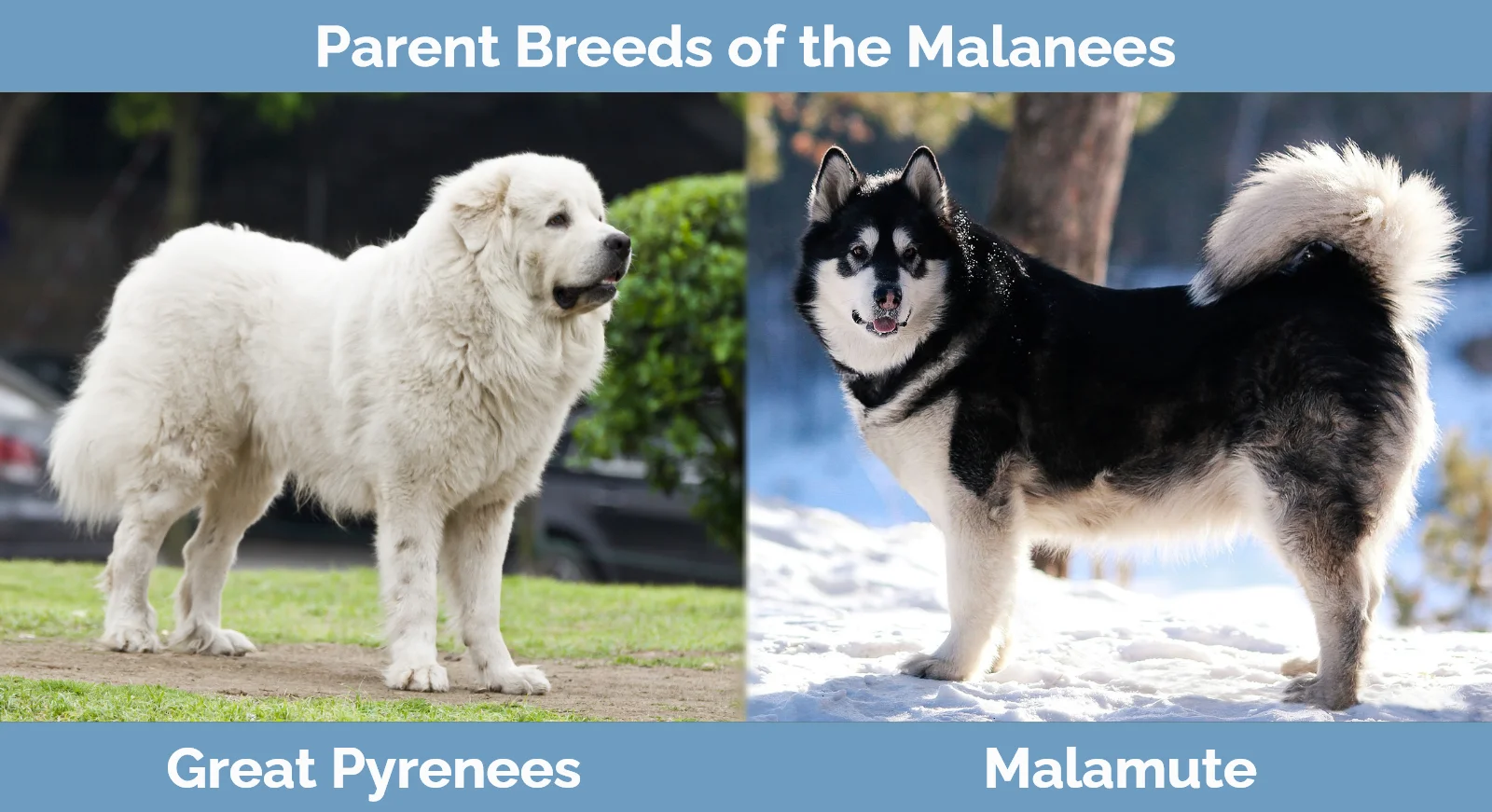
Temperament & Intelligence of the Malanees 🧠
The Malanees is an even-tempered and calm dog, with the Malamute side’s outgoing nature often making them friendlier than their more aloof Great Pyrenees parent. They’re bright and active, though not overly excitable, with a love for outdoor activity and having a job.
While they can inherit the Malamute’s tendency to howl or dig in the yard or the Pyrenees’s susceptibility to barking, the greatest challenge is their independence, especially that of the Malamute side. Confident and strong-willed, Malanees can be stubborn, insubordinate, and unwilling to show respect to an insecure owner.
Are These Dogs Good for Families? 👪
Malanees inherit an affection for children from the Alaskan Malamute and a patient, gentle demeanor from the Great Pyrenees, making them exceptional family dogs. With their guardian background, they’re naturally inclined to be protective of their pack, particularly the more vulnerable members. As a larger breed, they still need close supervision around small children to avoid injury.
Does This Breed Get Along With Other Pets?
Malamutes and Great Pyrenees may not get along with dogs of the same sex, especially those of equal size that they could consider a threat. They have dominant personalities and could invite conflict if not well-socialized. Otherwise, the Malanees can get along with other pets, thanks primarily to the Pyr’s mild temperament and protective nature around smaller animals.
Things to Know When Owning a Malanees
Food & Diet Requirements 🦴
The Malanees can grow to weigh over 100 pounds and stand over 30 inches tall. When mature, they need roughly 4 cups of dog food daily. Because Great Pyrenees and Malamutes are susceptible to bloat, the Malanees may benefit from 3–4 smaller meals throughout the day. A large-breed food is appropriate, and your dog will likely need to stay on higher-calorie puppy food for the first 2 years, as Malanees can take longer to develop.
Exercise 🐕
Although they aren’t the most active breed, especially with the Great Pyrenees’s laid-back influence, the Malanees still needs daily activity to maintain their weight and fitness. Malanees have a knack for and attraction toward pulling, which makes sledding and skijoring fitting pastimes. Providing cart-pulling jobs around the property can give your dog a delightful sense of purpose and a solid workout.
If you don’t have a job available, Malanees enjoy jogs and walks for exercise but can easily handle more demanding hikes, backpacking excursions, and organized dog sports. A large backyard for games of fetch is ideal for these sizeable dogs, as long as you have a fence that can resist the Malamute’s capacity for digging and climbing. Give your dog at least 1–1.5 hours of exercise daily, and they’ll be relaxed and easier to manage in the home.
Training 🎾
Training is the most challenging and vital aspect of owning a Malanees. Their testiness and stubborn attitude require a firm, dominant, and consistent leader to keep them under control and trainable. Leash training is often a struggle, as they’ll constantly pull, and their enormous unreliability with recall typically makes off-leash time unallowable unless in an area with a large fence.
Malanees respond best to positive reinforcement and frequent training. They’re easily distracted, usually tolerating only short sessions. Though intelligent and capable of learning commands and tricks, the Great Pyrenees’s independence and indifference can make teachings tricky to cement, while Malamutes often have urges to run off or dig that may be too powerful to overcome. Both dogs have the best chance for success if you exert dominance and approach training with patience, confidence, and affection.
Grooming ✂️
Although the Malanees is a relatively clean dog, the thick double coat will need considerable attention during the week. Fortunately, grooming is straightforward, if not infrequent. If they inherit the Pyr’s tangle-free coat, maintenance becomes even simpler. Daily brushing with a pin brush and comb will be necessary to remove the dead topcoat and undercoat. Your dog will shed throughout the year and blow their coat twice annually, requiring frequent de-shedding and constant vacuuming.
Health and Conditions ❤️
Due to their size, Malanees are susceptible to hip and elbow dysplasia. Depending on their build, they may also receive a higher risk of gastric dilatation and volvulus or bloat. The condition common to deep-chested dogs may only cause mild gas, or it could progress to a painful twisting of the stomach, resulting in a life-threatening emergency.
Although it can develop disorders common to either breed, the Malanees is less prone to unique genetic diseases because they’re a mix.
For example, day blindness and chondrodysplasia, an abnormality causing dwarfism, are genetic disorders among Malamutes. The genes causing them are recessive. They need two copies of the defective gene to show physical signs, which is unlikely with contributions from the Great Pyrenees.
Likewise, Great Pyrenees dogs may inherit neurodegenerative diseases that can worsen throughout their lives, but again, this is likely an autosomal recessive source that doesn’t often appear in Mals.
- Patellar luxation
- Elbow dysplasia
- Eye disorders (entropion, ectropion)
- Gastric dilatation and volvulus
- Hip dysplasia
Male vs Female
Malanees males and females are fairly similar except in size. Males are several inches taller than females and may weigh over 30 pounds more. They can sometimes play more aggressively than females, but spaying and neutering will often decrease the behavioral differences between the sexes.
3 Little-Known Facts About the Malanees
1. Malanees Are Excellent Weight Pullers
Channeling your dog’s intelligence and energy into stimulating and fun bonding experiences is crucial to earning your Malanees’s respect. While they will quickly take on almost anything task-related, signing your Malanees up for weight-pulling trials is a natural fit.
Malamutes were born to pull loads. While not fast dogs, they are incredibly strong and notably have possibly the highest endurance of any breed. They’re champion weight pullers. As an even larger dog, the Great Pyrenees similarly has a talent for the sport. Combining their personalities in the Malanees offers a hybrid perfectly fit for competition.
2. Malamutes and Great Pyrenees Were War Dogs
The Malanees’s parents have plenty of military service between them, as utilitarian breeds were indispensable in WWI and WWII. Hardy and athletic, the Malamute and Great Pyrenees made ideal workers in the intense snow and frigid cold of the European war zone. Using their pulling prowess, both dogs were supply transporters and artillery haulers, with the Malamute pulling additional duty as a search-and-rescue dog.
3. Malamutes Were Part of the 1925 Serum Run
Though Huskies like Togo and Balto earned the glory during the 1925 Serum Run, they were hardly the only dogs to contribute. As an Alaskan native, the Malamute would have had a more difficult time not factoring into the 674-mile-long relay. The Malamute team braved treacherous terrain and cold weather conditions to carry life-saving diphtheria medicine to Nome.
Final Thoughts
The Malanees demands and deserves respect. They are dignified, confident, and capable, and it takes an owner with similar traits to command their admiration. If you can provide the care and patience needed to take charge, the Malanees will richly reward your home with their affectionate, gentle, and good-natured spirit.
See also:
- Alaskan Malador: Care, Pictures, Traits & Characteristics
- Malamoodle (Alaskan Malamute Poodle Mix): Care, Pictures, Traits & Characteristics
Featured Image Credit: Left – Beatrice Foord-St-Laurent, Shutterstock | Right – Till Daling, Pexels



